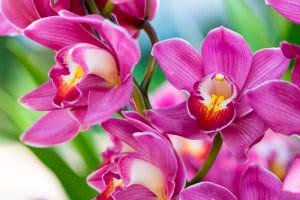Orchids are among the most beautiful flowers. Bringing them home could be like adding a gem to your miniature garden. Growing them is addictive as well as very tricky.
If you are alien to the concept, we have something here that might help you out. Growing orchids can be categorized mainly into two parts:
Potting
Is it easy to put up? Not so much. Potting is like setting up a base for your orchids to grow. It is the foundation that defines beauty, quality and quantity of it.
1. Orchid Species
Selection of right species plays a major role. Thankfully, most of them that you find in the nursery are the hybrid, especially to yield more flowers. Some are easier to grow than the others. I would recommend Cattleya, Phalaenopsis, and Paphiopedilum as they are easiest to handle.

2. Soil for orchids
Orchids don’t grow in regular potting soil. Their roots need way more air than regular flowers. Also, every orchid species requires a different type of conduit as per its needs.
You must always go with porous and breathable potting mix. Usually, people use coconut husks, bark chips, sphagnum moss, etc. Or you can consult an expert.

3. Pots for orchids
Use small snug pots till your plant fully grows. Most orchids grow beautifully when they are root bound. Make holes in the pot for excess air and to avoid over-watering.Other types of pots that are recommended are net pots that have wire mesh. Another one is the clear plastic one that gets better sunlight for the roots. Buy pots & planters online for orchids.

4. Seeding
You must be patient if you are planting seeds instead of getting a pre-potted one. Few recommended steps are:
- Sterility – It makes sure your environment is sterile.
- Planting – Plant them beneath the immediate layer of the pot.
- Fertilizer – Always go for an environment-friendly one. The required time and amount differ from species-to-species.

5. Pot the Plant
Once orchid has reached a desired shape or size, remove it from the original pot and make sure to cut off rotting and dead roots. Divide root matter as desired, preferably against the wall of pot and barely cover it with potting mix. Buy potting mixture online.
6. Repotting Orchids
Repotting is a necessary step. Different orchids have a different re-potting cycle. Some plants such as Paphiopedilum and Phalaenopsis need repotting yearly while some like Cattleya goes bi-yearly.Now that you have potted your plant, there are a few things you must keep in mind.
Orchid Care or Fostering
1. Temperature
Common orchids like Phalaenopsis should be comfortable at a day temperature of 21 to 29 degree Celsius. There should be about 6.66 degrees difference between day and night.
2. Sunlight
They are sensitive to direct sunlight. Place them in a place where they can get ample of indirect sunlight, the amount required varies from species-to-species, which can be determined by checking leaves.
- If orchid leaves are dark green, it means they are not getting enough sunlight.
- If orchid leaves turn yellow, brown or reddish, then it means they are getting too much sunlight. The ideal color should be evenly light green.

3. Water
Over-watering can easily kill your orchids and the time difference may vary from 5-12 days easily. Easy pointers for water requirements also can be determined through their leaves.
- Thick Leaves – It need larger dose of water
- Bulky Faux Bulbs – They require less water than others
Remember, different species and genera require a different amount of water.

4. Nutrition
Fertilizers easily provide nutrition to orchids. They mainly need nitrogen, potassium, sulfur, calcium, phosphorus, and magnesium to grow. Do not over-fertilize; they can burn the roots and hamper flowers.Always keep your plant clear from unwanted weeds. These undesirable plants share food and nutrition like sunlight and water of the desirables, decreasing their yields. Weeds can increase the breakdown of orchid’s potting mix.
To avoid it, I would not recommend herbicides as they pose too much risk to delicate orchids. Use only best crabgrass killer to remove garden weeds.

5. Humidity
Most orchids like 60% - 80% atmospheric humidity to grow. As the requirement is more than the average humidity of the home, you need to create a more humid environment for your orchids. A few basic tricks are-
- Spray - Frequently spray water on your plants.
- Tray - Put the orchid pot on a tray that contains water. Slow evaporation will help in keeping your orchid desirably humid.

6. Pruning
This simple and important step refers to trimming dead roots, flowers, leaves and stems to avoid further decay or drying up. Pruning increases the beauty of the orchids and gives them a longer life. Understand pruning in depth.And Finally,
You must understand that each orchid is different and so are care taking requirements. They need a different amount of temperature, light, water, fertilizer, etc. depending upon the species you choose. They add beauty to your life and reflect your personality. Well, you deserve a bouquet of orchids for all that pain you have taken!












